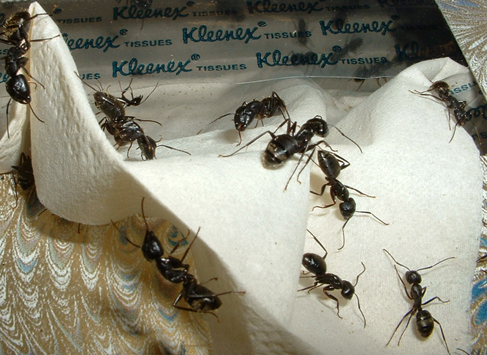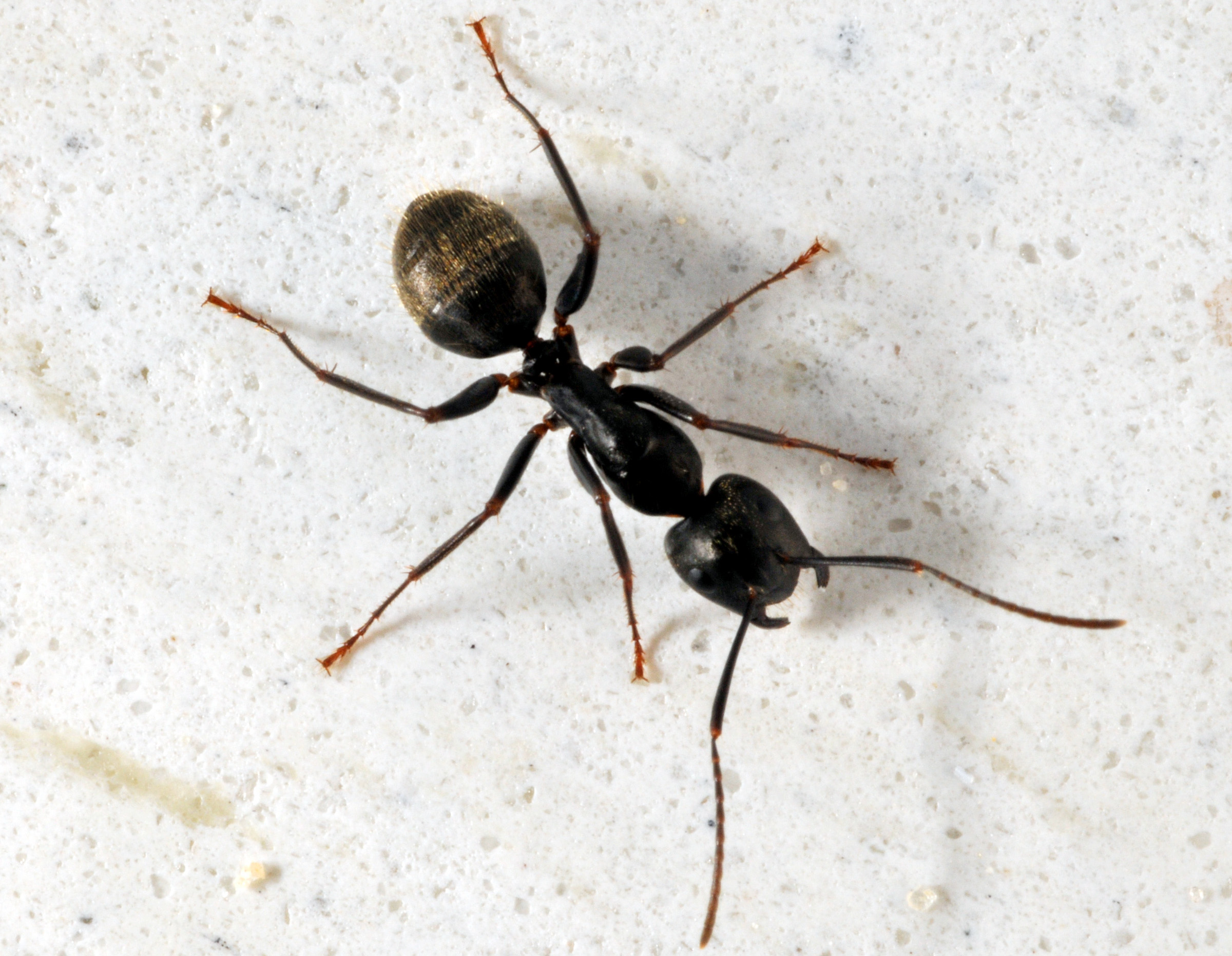Household and structural
Ants
Gary W. Bennett and Timothy J. Gibb, Extension Entomologists
If you want to view as pdf, click here
Ants are very common and valuable insects throughout the world. Their tunneling helps aerate soils and many species feed on insects that may become pests. However, ants can also become a problem in the home. Most ants build nests in soil. Those that invade buildings usually nest near foundation walls or under concrete slabs. One species—the carpenter ant— builds its nest in hollow trees, stumps, and sometimes in the timbers of buildings.
DISTINGUISHING ANTS FROM TERMITES
Sometime during the year, all ant colonies produce winged individuals, which homeowners often mistake for termites. Here is how to tell them apart:
An ant has a narrow “waist” like a wasp, while a termite has a straighter body and no waist. Ants have four wings of unequal length (front pair longer than the hind pair) that are clear like those of a house fly. Termites also have four wings, twice as long as the body, milk-colored, and of equal length. Ants swarm during the spring, summer, or fall, but termites usually swarm only in the spring.
PREVENTION AND CONTROL IN BUILDINGS
The best way to prevent ants from invading a house is to locate and destroy their nest. Look in the soil around the building’s foundation; control as you would for ants in the lawn (see directions at the end of this guide).
However, if ants still get into the house, apply insecticides where the ants gain entry or hide—at foundation walls, doorways, windowsills, baseboards, behind built-in cabinets and furniture, beneath refrigerators, and other heavy appliances. A number of effective, ready-to-use household sprays are available as spot treatments for ant control. Look for household sprays labelled for “crawling insects” or “roach and ant” control. Ant baits are also available, but you may have to try more than one bait to find one that is effective for your ant problem, and they may require 10 days or more to produce the desired effects.
Houses built on concrete slabs often have serious ant problems. The insects nest under the slabs and enter through cracks, heating ducts, and utility openings. Professional pest control may be needed in this situation, and for carpenter ants.
Carpenter ants
(Photo credit: Jody Green )
Carpenter Ants: These are large, black ants, either winged or wingless, measuring up to 1/2 inch long. They construct their nests in hollow trees, logs, telephone poles, posts, porch pillars, and other timber used in homes. Their trademark is a small pile of coarse sawdust beneath their nesting site. These nests usually are found in wood with a “higher than normal” moisture condition.
Carpenter ants differ from termites because they do not consume wood, but simply hollow it out to form nests. While usually not as serious as termites, they can weaken building structures.
The secret to control is direct treatment of the nests. Look for the piles of sawdust to locate the entries, then treat the “galleries” by injecting spray or dust.
To prevent carpenter ant invasion, spray foundation walls and adjacent soil with a formulation labeled for this use. Exclude ants by sealing cracks and openings on the exterior of buildings, and by keeping overhanging branches trimmed away from the roof line.
CAUTION
All insecticides are potentially hazardous. Therefore, do not apply on or near food or on surfaces where food comes into direct contact. Wipe-up any excess spray. Be sure to read, understand, and follow all label directions.
ANTS IN THE LAWN
Recent research indicates that ants serve a valuable role in turfgrass. Many potential insect pests, including grubs and cutworms, are controlled by natural ant populations. Because of this, it is rarely advisable to treat lawns for ants. Where ant mounds occur, however, they can be unsightly and may interfere with mowing. To destroy mound-building ants, lightly soak the mounds with a labeled liquid insecticide. A number of insecticides are available for this use, including emulsifiable concentrates, sprayable powders and granules. Use only formulations labeled for ant control in lawns, and follow label directions. If a hose-attached sprayer is used, agitation must be maintained while spraying. Water and roll or hand rake the mounds to ground level after treatment.
Photo of a single carpenter ant.
(Photo credit: John Obermeyer)
While ants are typically found foraging in kitchens or other areas where open water (moisture) and food sources are available, their nests may or may not be close to these resources
(Photo credit: Shuster and Provonsha)
READ AND FOLLOW ALL LABEL INSTRUCTIONS. THIS INCLUDES DIRECTIONS FOR USE, PRECAUTIONARY STATEMENTS (HAZARDS TO HUMANS, DOMESTIC ANIMALS, AND ENDANGERED SPECIES), ENVIRONMENTAL HAZARDS, RATES OF APPLICATION, NUMBER OF APPLICATIONS, REENTRY INTERVALS, HARVEST RESTRICTIONS, STORAGE AND DISPOSAL, AND ANY SPECIFIC WARNINGS AND/OR PRECAUTIONS FOR SAFE HANDLING OF THE PESTICIDE.
November 2017

It is the policy of the Purdue University Cooperative Extension Service that all persons have equal opportunity and access to its educational programs, services, activities, and facilities without regard to race, religion, color, sex, age, national origin or ancestry, marital status, parental status, sexual orientation, disability or status as a veteran. Purdue University is an Affirmative Action institution. This material may be available in alternative formats.
This work is supported in part by Extension Implementation Grant 2017-70006-27140/ IND011460G4-1013877 from the USDA National Institute of Food and Agriculture.
1-888-EXT-INFO
www.extension.purdue.edu
Order or download materials from www.the-education-store.com





